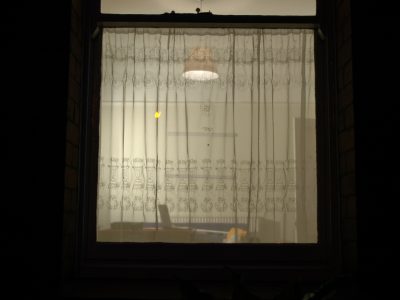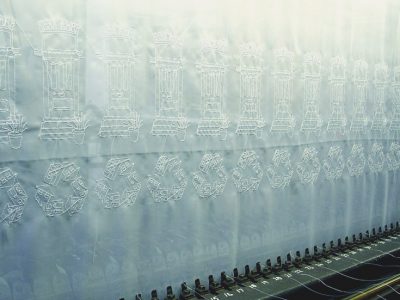Nina Edge, Nothing is Private, Independents Biennial Liverpool, 2006
Real Life, the Private and the Public, On Nina Edge
Liverpool-based artist Nina Edge’s life is her work, in a way that could in principal be related to the ongoing, mammoth Real Life projects of Glasgow-based artist Ross Sinclair. Like him she works with modern motifs, symbols of the institutions that define our lives and institutional contexts, the individual in relation to those institutions and ideas that flicker between the public domain and the private existence, between policy-making, think-tanks of progressive actions, sweeping changes to social dynamics and their effect on life and society. Her array of output in material and conceptual terms is equally broad, from performance to objects, installations to interventions, activated and activist responses and fabric-based pieces and texts. All rooted in a contextual, conceptual response to issues, political circumstances and community-sited actions and activities. These issues and ideas, though, are directly sourced from her own situation not abstracted from objective observations, but from something lived through, experienced and challenged on a day-to-day basis.
I conducted a lengthy conversation with Nina over the phone in preparation for her new piece to be shown during Independents. During the conversation we discussed a number of weighty issues, a number of political changes we have both witnessed since Thatcher and the changes she has made to her approach to being an artist and making art. We spoke also about the terror waged by Britain against itself, of Bush and Blair as masters and defenders of the shareholder, the paranoia devised by the media and our politicians, and the journey that we have gone in recent times from optimism to dismay.

She started off by describing the installation and production of her new work for Independents. The piece is a specially-made net curtain to be installed in the front room window of her terraced home; the net curtain she explains is a form that at once conceals and reveals, decorates, adorns and disguises, it speaks of a very British phenomenon related to home, class and period. The net curtain I remember was used during an installation at Tramway by Pipilotti Rist called Show a Leg in the early part of this decade. Rist’s video projections light was caught on and spilled through screen upon screen of net curtains beautifying the vast space of Tramway’s main gallery. All frilly forms, whirling stitching, floral patterns and curving fringes filling Tramway with images of outside and inside, vibrant video colours and human bodies in motion and fall. It was a beautiful experience. But Nina Edge’s net curtain is a more rebellious, disobedient piece of work additionally rooted in protest, and polemic and political slogans; it is an invitation to peek and vocalize at the same time. It has been made as a direct response to the disintegration of public and private, of governmental scrutinizing on personal affairs, on policies that effectively make communities disappear, of the enrichment of the wealthy and rendering the dissident as extremist, the market-force and profit as paramount and an action to demolish a way of life and homes literally to enhance the portfolios of property developers and replace public and social liberties and responsibilities with private ideologies, agendas and values. The net curtain has been made, as Edge describes: “is the only way she knows how to” in response to misguided social engineering though she is becoming more and more conversant with legal speak, administrative jargon and political policy loops. She divides her time with art production and leading an action group in protest at the willful destruction of her way of life and the lives of others in her community.
So instead of the usual net curtain, familiar, kitschy, floral and feminine we will see a beautifully made political graphic sewn on a machine that is heading for obsolescence, removal, disappearance itself. Edge is not critiquing progress or change; she is though critiquing changes that defy, devalue and fragment what we come to term as “our way of life”: our free speech, our liberties or our ability to debate and protest. Changes that are replacing core values with profits, social needs with spreadsheets and existence with economics.

Nina Edge lives in a community that is being threatened by physical and social annihilation in order for a programme of new house building to occur that will place housing stock in the hands of private concerns. It is a policy of the short-term and abstracted; it pulls resources away from where they are needed and sets up competition where the public and private are merged, mainly to the detriment of the public and the growth of the private. Edge asks a fundamental question: what is the private and what is the public? She is an artist who works at a grassroots local level because it’s happening to her; the threats to her way of life are happening to her and by extension to us all. This work is made from a need to articulate, communicate and inform. It is immediate, tender, desperate, engaging, inviting, social, elaborate, reactive and active. It is finely conceived, in the tiniest of details, inviting inspection and broadly formed, demanding action.
Real Life. Indeed.
Alex Hetherington Catalogue Notes, Nothing Is Private, a textile piece showing at the artist’s home
Independents Biennial Liverpool 2006
ISBN 0-9550808-2-7
